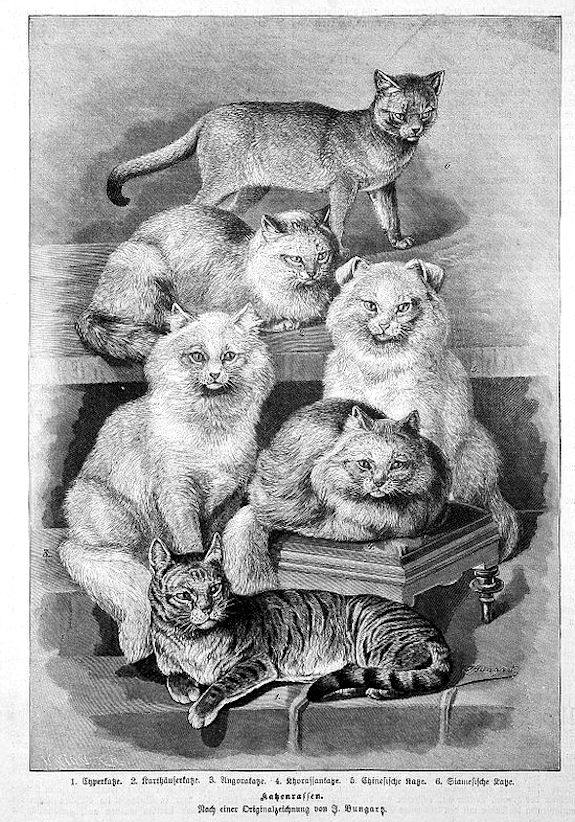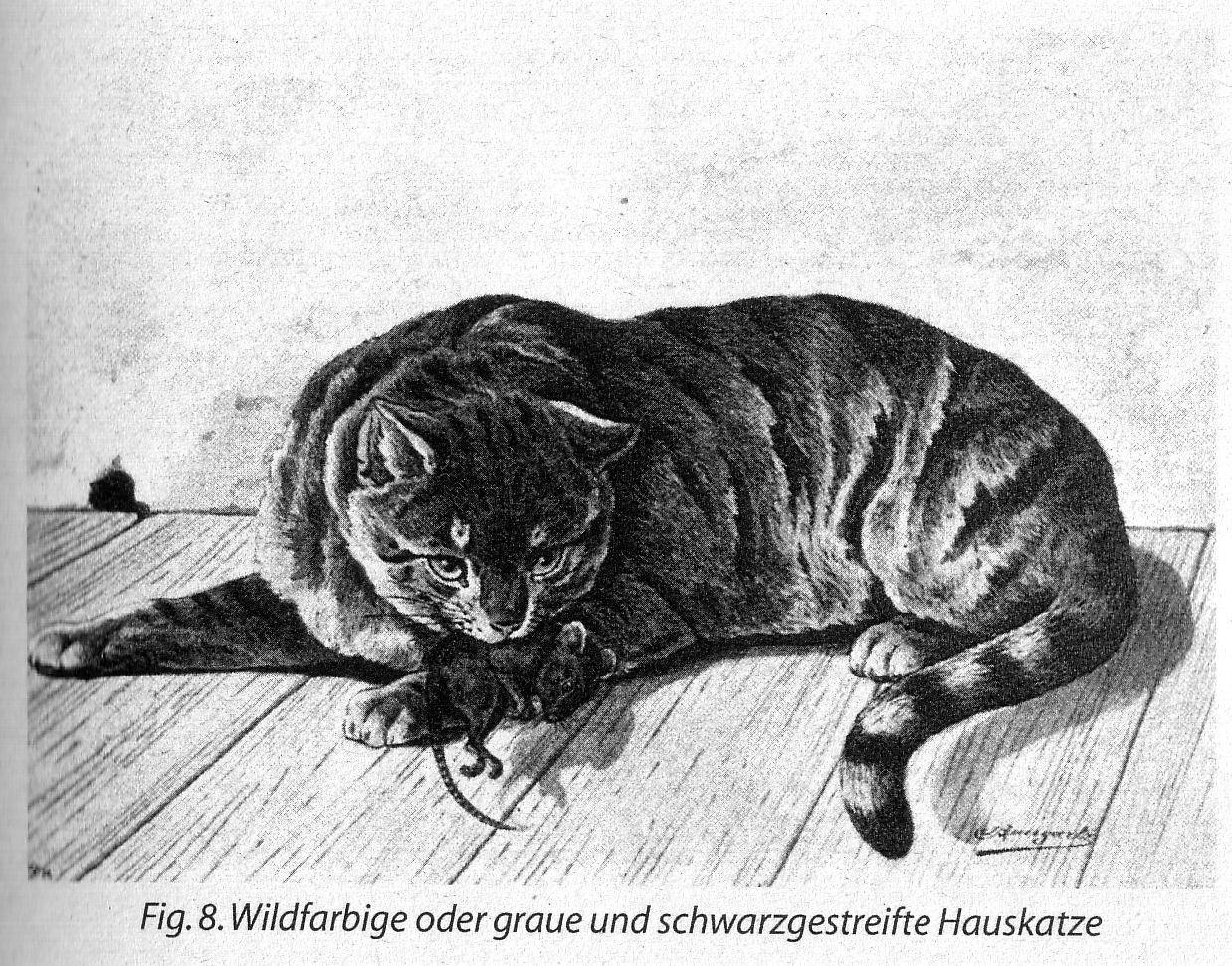
AN ILLUSTRATED BOOK OF CATS – HOUSECATS, THEIR RACES AND VARIETIES (JEAN BUNGARTZ, 1896)
"Housecats, Their Races and Varieties" is a chapter from "An Illustrated Book of Cats" was written and illustrated by Jean Bungartz and published in Berlin in 1896 as “Die Hauskatze, ihre Rassen und Varietäten” in “Illustriertes Katzenbuch.”
Regarding the development of breeds, the domestic cat has been quite able to keep on being independent and has changed little. With all other household pets we find a number of races and varieties, but just a very few distinct races among domestic cat. Their footloose and fancy-free lifestyle, desire for freedom, independence, and self-love did not permit breeding according to the current rules of breeding because pressing cats into these constraints is very hard and any transformations they go through can only be seen and identified in the colour and structure of their hair. The way their body is built has stayed the same, and you can only observe real changes in specific body parts in the lop-eared cat from China and the tailless cat from the British Isle of Man.

Fig. 8. Wild-Coloured or Gray and Black Striped Domestic Cat.
The physical characteristics of the domestic cat have been described in a previous section and it only remains to describe some of the established colours and the foreign races and varieties.
Firstly, the attractive colouring of the wild-coloured or grey-and-black tabby variety of the domestic cat (Fig. 8) from which all other colours were developed. This cat approximates the wild cat in its colour and can be confused with a particularly large and strong domestic cat except for the unfailing distinguishing factor of the longer, more pointed tail of the domestic cat.
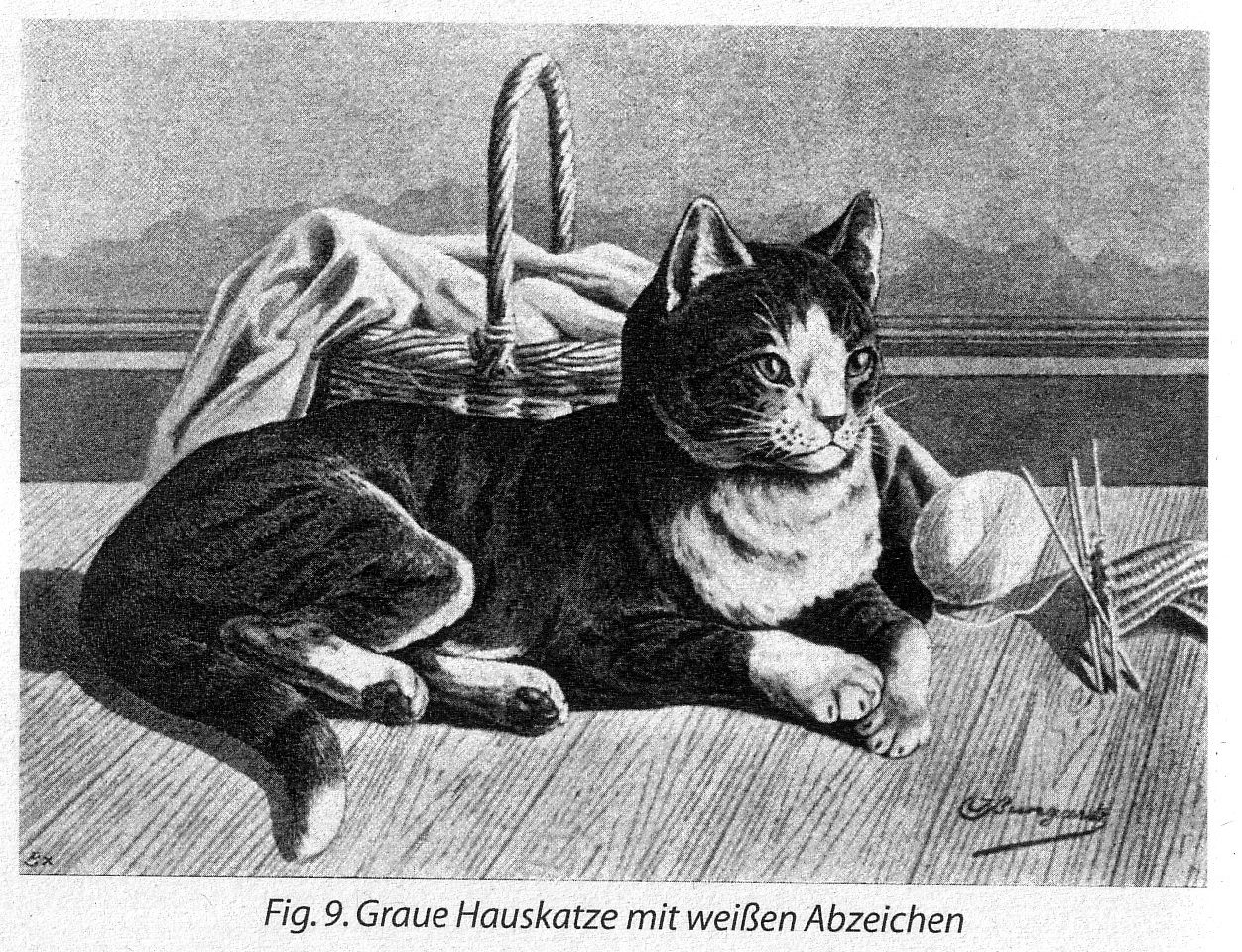
Fig. 9. Gray Domestic Cat with White Marking.
The basic colour is yellow-grey, yellowish on the legs and chest, sometimes extending somewhat to the face. The body is marked with dark black-grey stripes and spots. Cats which have large markings instead of the crosswise longitudinal stripes are highly prized. The eyes are greenish-yellow, the nose, lips and often the soles of the feet are black or are marked with black. This variety is also usually wild in nature and one of its characteristics is its greater instinct of self-preservation - they go wild more easily and will mate with Wildcats; Wildcats will accept them as mates if they abandon their masters’ homes and roam wild outside. It is generally believed that tabby cats are the best mousers.
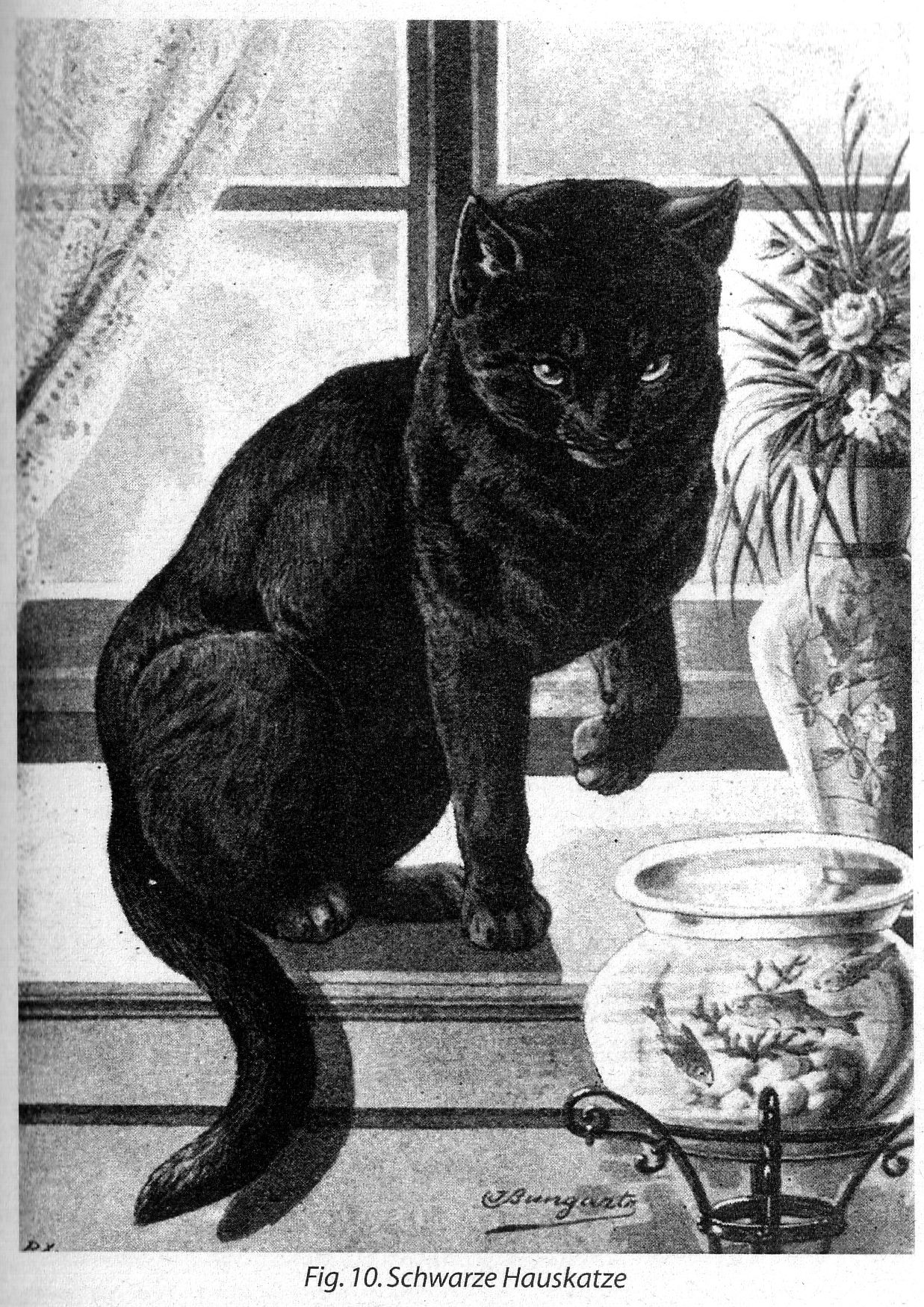
Fig. 10. Black domestic cat.
Another very popular variety is the more bluish-grey hued cat (Fig. 9) which usually has white markings on the face, chest, feet and tail.
Black cats should be very pure in colour, without any hint of rustiness nor any white markings and they have beautifully yellow eyes. This is considered the most beautiful and also the most rarely found type. Apart from size, it resembles a black Sunda panther. Usually the black colour has, in sunlight or bright light, a brownish tint; and then the dark transverse markings are faintly visible to the eye, and these cats’ eyes are not the preferred beautiful light yellow colour. Really black cats without even the smallest white patch, are wonderful and much sought after animals and fetch high prices.
The white variety is very common and is considered soft and not as resilient as the previous cat described. Although white cats with blue eyes, are quite graceful animals when their fur is clean, one rarely sees them in this condition in the cities. Usually the hair is thin and dull, nevertheless, careful grooming could do a great deal to make the coat more substantial. Many white cats are either completely deaf or have poor hearing and are consequently inferior mousers. A pretty white kitten, well-cared for and kept clean, always stands out from others.
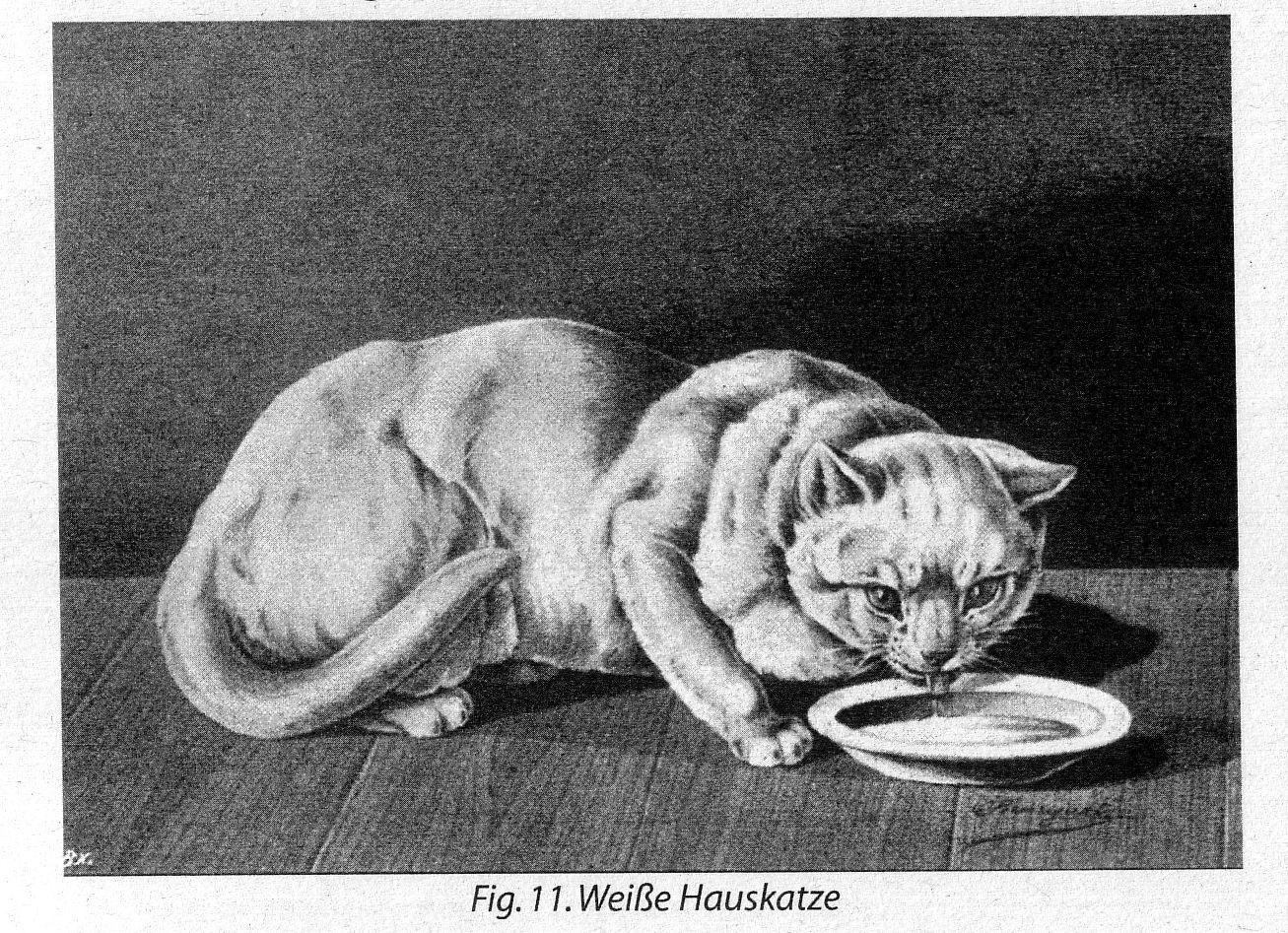
Fig. 11. White Domestic Cat.
The Masked Cat is usually jet black with a white snip between the eyes; the lips, cheeks and chest (sometimes as far as the throat) are also clean white. The belly and paws and sometimes the tail-tip are also white. The eyes of this variety are bright yellow with black rims. Regular and sharply defined white patches produce the most beautiful Masked Cats which have many admirers.
The black-headed or Mohrenkopf (Moor-headed) cat (Fig. 12) must be clean white, with contrasting colour on its head and tail. Consistent specimens of this variety are extremely rare and it can probably be regarded as one of the most peculiar colour patterns of the domestic cat. The colour of the head and tail can be either black, grey, blue or yellow with no white hairs except those regularly showing up on the head. A previously mentioned, cats with good and correct markings are highly valued.

Fig. 12. Black-Headed Cat.
Mouse-brown or pale-grey, yellow and spotted varieties (Fig. 13) are commonly found and the colour gradations and patterns are very variable, so that no firm standard can be set.
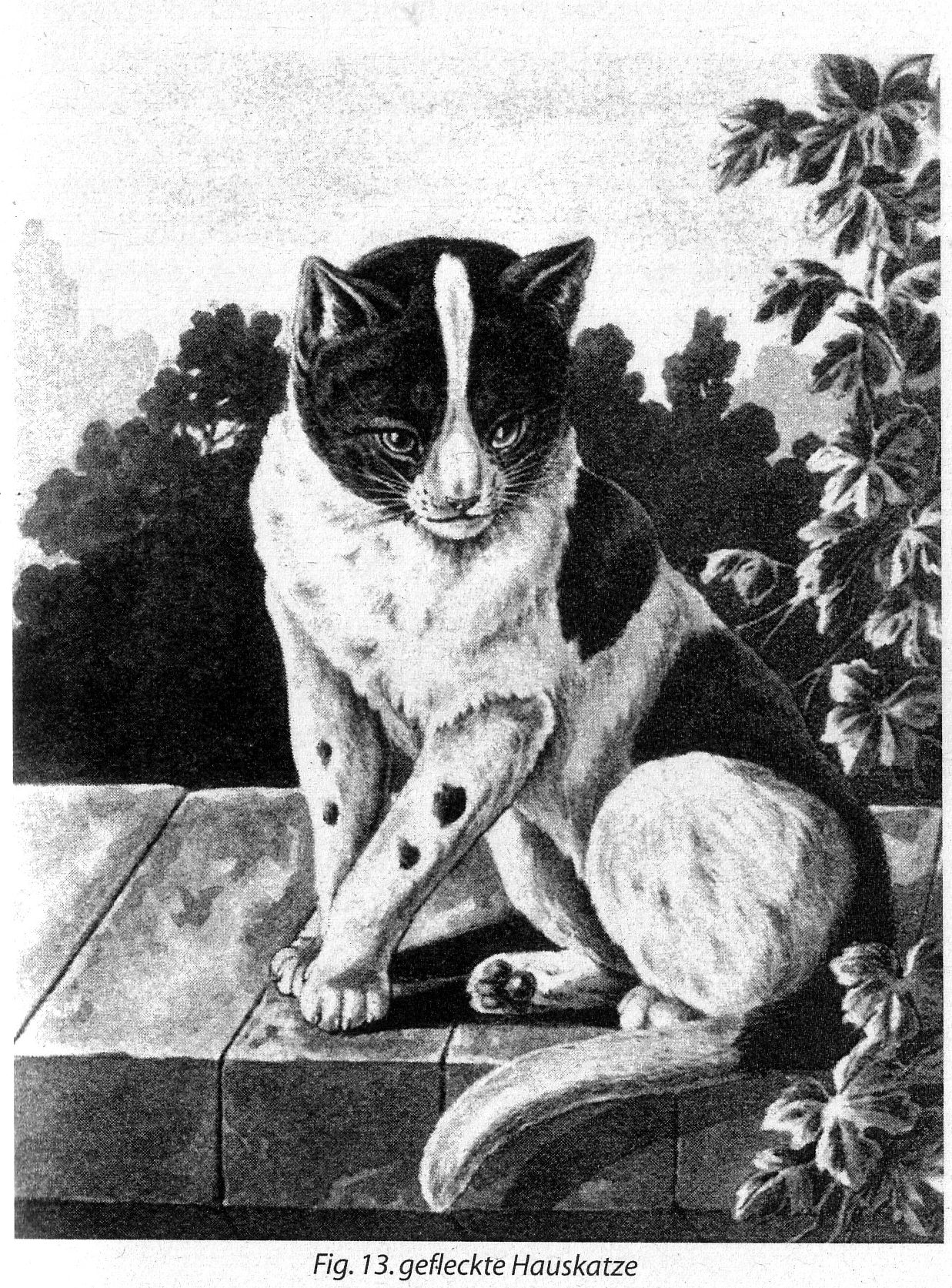
Fig. 13. Spotted domestic cat.
Purely mouse-brown cats or pale-grey and yellow cats without white markings are still attractive cats, and even among the spotted cats there are some quite pretty animals. The ground colour is white with irregular coloured patches over the head and body. Those cats where a coloured mask covers only one side of the head are rather ugly. These patched varieties account for most of the mixed type domestic cats and they occur in a wide palette of colours and design that is almost indescribable.
The three-coloured or Spanish cat. The term "Spanish" does not mean that this variety is restricted to the Pyrenean peninsula and it is difficult to describe why it got this name when pushed for an explanation. It is less common than the varieties described previously and outstanding beauty is not its main characteristic, however there are some which make a favourable impression due to their good colour and regularity of markings. The background colour is white, on which mixed patches of brown, yellow or grey are scattered over the body. It is generally says that this pattern is only found in female cats, and that three-coloured tomcats are very rare. Since the female sex predominates in this cat, this may not be surprising, all the more so as the three-coloured variety can turn up in any litter. These cats are nonetheless beautiful when the markings on the face and body are regularly distributed. Unfortunately the markings are all too often mottled and run into each other which makes the individual colours hard to make out. Also, if the face is unpleasantly or unevenly marked and has a large mark on one side, but not on the other, it makes the cat rather unattractive.
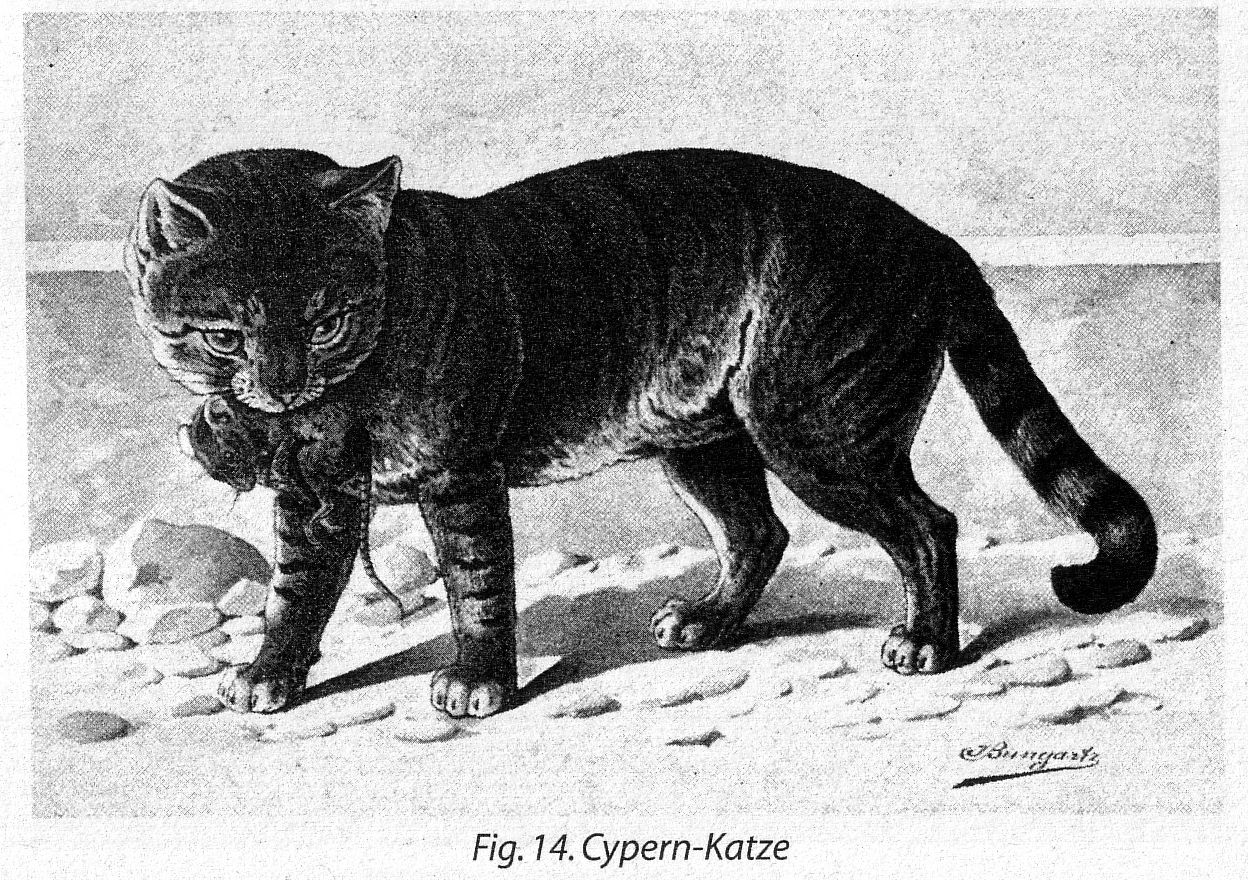
Fig. 14. Cyprus cat.
The Cyprus cat (Fig. 14) is yellow grey with black stripes and appears to have been carefully bred on the island of Cyprus. According to Michel, at Villamont on the Cap della Gatte (Cape of Cats) in Cyprus there was a monastery which was destroyed by the Turks; living there were cats that waged a very effective war on the large numbers of snakes in that area. Michel said of the snakes on the island "they are black and white, at least seven feet long, and around six to eight inches thick and they are hunted and killed by the monastery cats. At noon the monastery bell calls these bold hunters to the meal, but as soon as they finish their food they resume anew their pursuit of their enemies."
In all probability the Cyprus cat has been preserved in its original colour and form. But not all yellowish-grey, black-striped cats are genuine Cyprus cats, unless their ancestors come from this island.

Fig. 15. Carthusian cat.
The Carthusian cat (Fig. 15) is a self-coloured blue variety with long fine hair, black lips and black soles to its feet. The blue colour varies from bluish ash-grey to bluish-black. If the colour is pure-bred and the hair is in good condition, then the Carthusian is considered a most magnificent animal, but its character is somewhat phlegmatic, a characteristic it shares with other longhair cats such as the Angora, the Persian and the Chinese cat.
The Icelandic or Kumanian cat, and similarly named cats, are almost identical to the previous variety. The distinctive feature of the Icelandic cat is its beautiful bluish-grey colouring; the Kumanian cat, originating from the Caucasus, on the other hand, has thick white, black or rust-red fur and flesh-coloured lips and soles of feet.
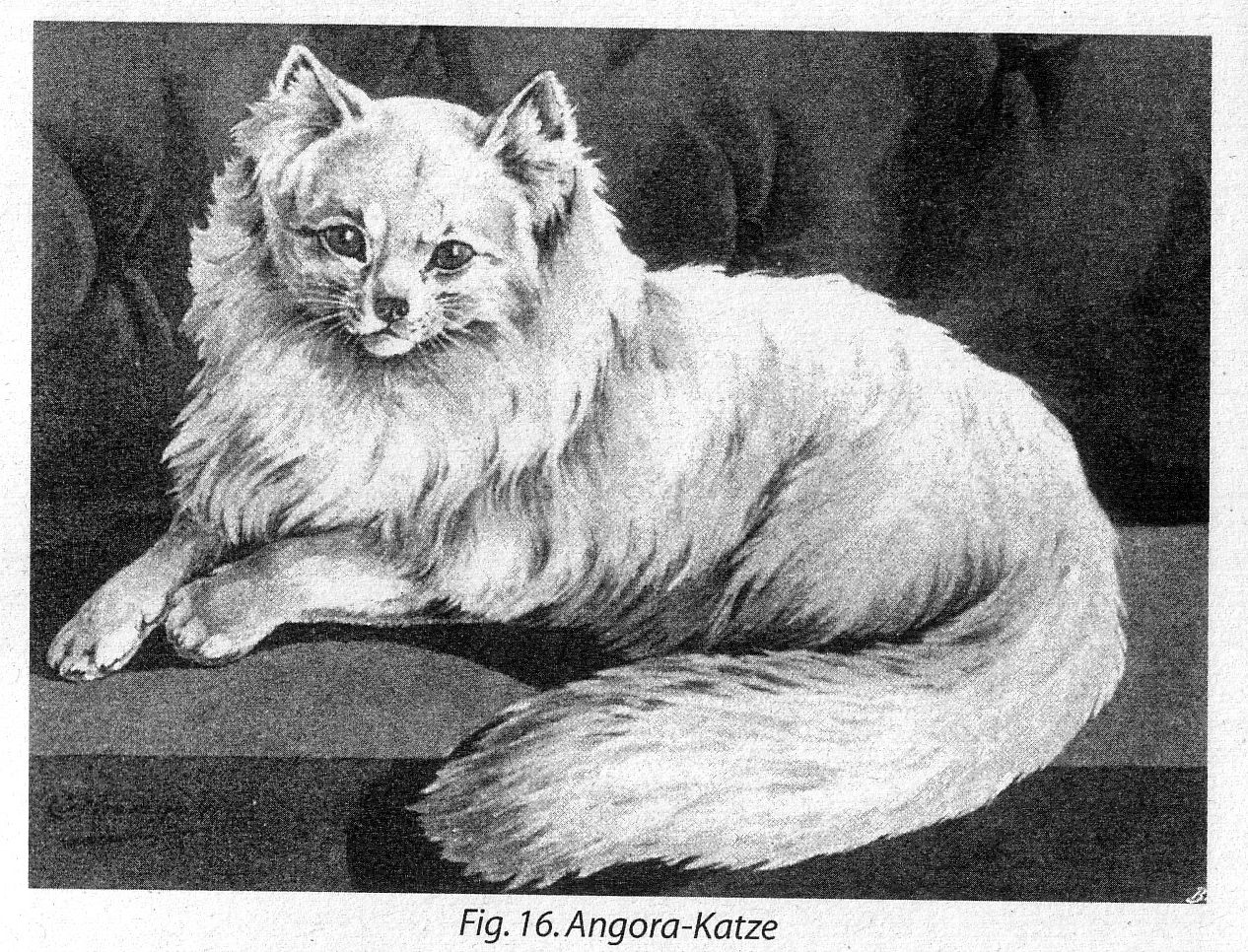
Fig. 16. Angora cat.
The Angora cat (Felis maniculata domesticus angorensis) (Fig. 16) is the most beautiful, most precious and best known of the foreign cats. This splendid, noble animal originates from high Asia, and Pallas believes the Manul is the ancestor of Angora, an opinion shared by Fitzinger. Brehm, however, thinks it more likely that it is just a breed whose characteristics are due to the climate of the mountainous regions in which it developed. Radde, in the south of Siberian, apparently saw only beautiful grey or blue-grey Angoras.
Chinchilla cats. In the small town of Tjumen, a little east of the eastern slopes of the Urals, he first met with these and more were to be found in the Russian settlements, but there were less common that the normal house-cats.
Whether Angora really is the homeland of this elegant and aristocratic cat, can’t be proved with certainty; but we are inclined to think so because of the longhaired Angora goats and rabbits that are found there. Either way, this cat is considered a distinct race because it passes on its characteristics reliably. A well-maintained Angora cat, resplendent in full coat, is undisputedly the most attractive of cats.
Outwardly it resembles the lion since a full mane hangs from its face, neck and chest. The hair of its back and sides is especially long, as is that on the tail, which appears longer and bushier than it really is. The hair inside the ear is long and tufted and that on the paws is shorter. The hair itself is silky, glossy, soft and has a slight curl. The white and silver-coloured varieties are the most popular, followed by blue, black, grey-striped and isabelline (cream). Other colours suggest the influence of foreign blood. Crosses with ordinary domestic cats do not show the full, rich, silky hair.
Angora cats seem to be very aware of their beauty, and their great intelligence make them sensitive to flattery and they love to be admired. They possess a calm, nearly phlegmatic temperament and are laid-back, but they have pleasant manners and a noble, aristocratic bearing. Because the Angora loves to be close to her human family, it is a popular salon animal which likes to do nothing more during the day than lie about on soft cushions, so it is always among human company. It is praised for its devotion and wisdom and it seems that she always wants to keep an eye on her master or mistress as she follows purring in their footstep, demanding to be petted. She is, in the truest sense, a pampered child a precious possession.
If we gave our other cats the same care and loving treatment then we might assume all the usual house-cats would have trained themselves to become more companionable.
If you own, care for and breed Angora cats, you must take great care of their long rich hair as this requires careful treatment. If you don’t take proper care of it the hair becomes matted, especially in the moulting season when the new coat is growing through. If you don’t, the Angora loses its good looks and turns into a horrible tangled mess. It needs to be regularly combed with a blunt-toothed comb, otherwise the clumps of hair can be torn out and cause pain. The cat generally attends to its own tidiness, thanks to its innate cleanliness, and it will groom and wash its fur all day. Its eyes can be wiped clean each morning with a soft sponge and lukewarm water. Anyone who has a real and beautiful Angora cat will be enchanted by its noble beauty and its good manners. It demands much and gives little in return, seldom catching a mouse even if one walks right in front of it, she is a soft and pump creature that likes to loll about and be fed on the choicest titbits. But all this cannot disguise the fact that it is a pleasure to own such an indisputable beauty among cats.
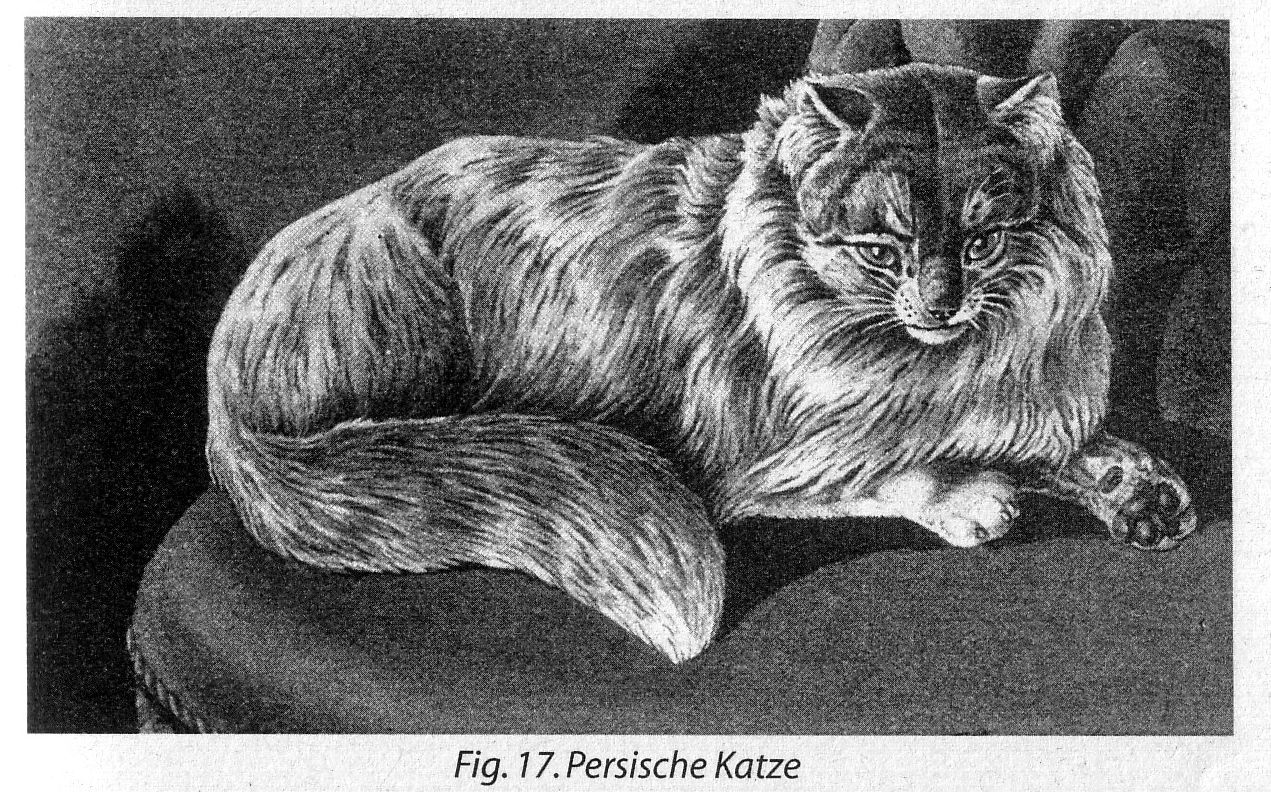
Fig. 17. Persian cat.
The Khorassan or Persian cat (Fig. 17) seems to be a variety of Angora cat. Its hair is somewhat woollier and curlier, but, like the Angora, is particularly long. In colour it is slate-grey. In terms of beauty, she is quite close to the Angora cat, but is far less common.
The Chinese or Lop-Eared Cat (Fig. 18) is most interesting, because it demonstrates that by continual disuse of an organ, the organ atrophies. So it is with the Chinese cat that both its hearing and the ears themselves have deteriorated. Michel says that the Chinese not only admire the cat in porcelain, but also value it for culinary reasons. The cats are regarded as special titbits and are chained and fattened up on rice."
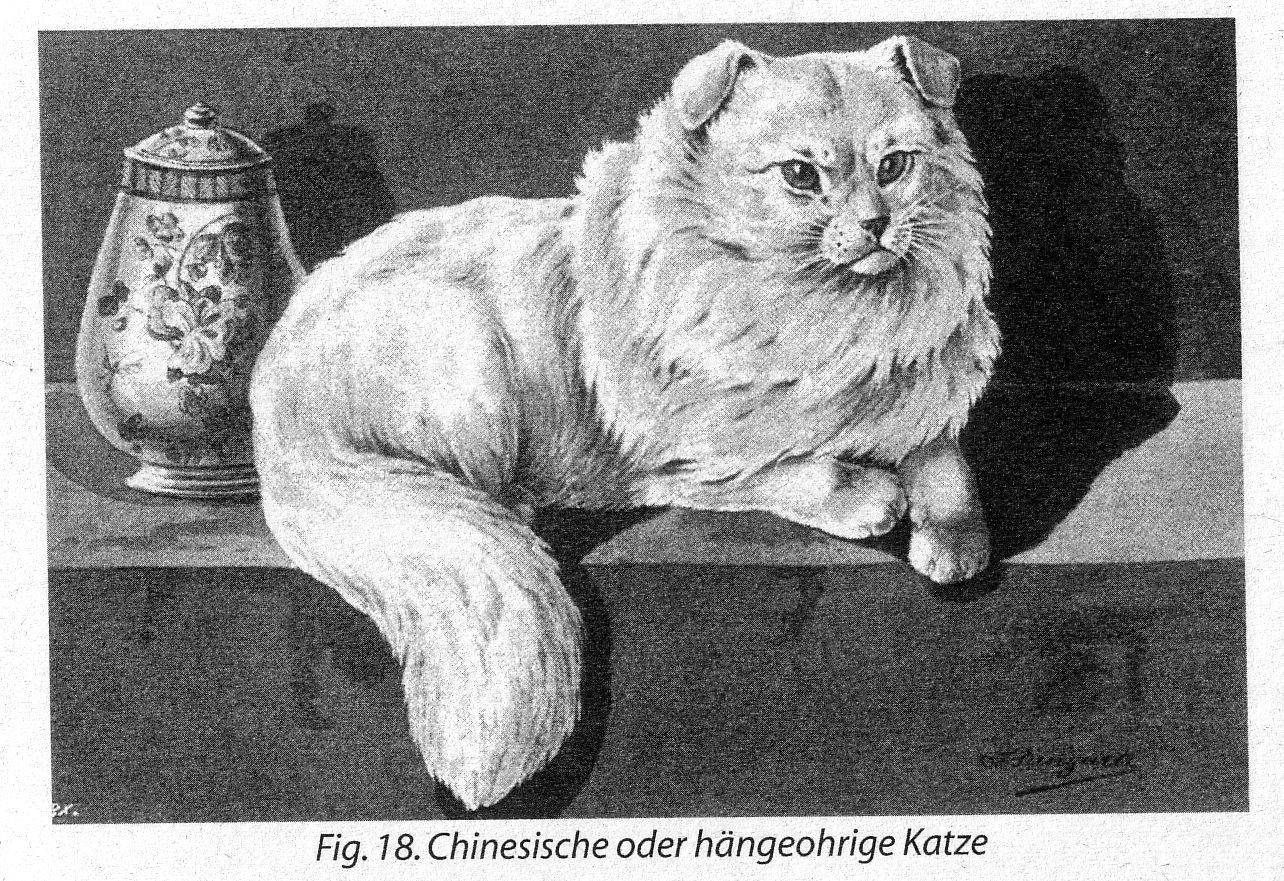
Fig 18. Chinese or Lop-Eared Cat.
This cat is bred particularly for the purpose of meat production, and is a preferred Chinese titbit; this is not unusual if one considers that the Chinese consume many things that would turn the stomach of a European. The poor creature is locked up in small bamboo cages and, much like a kind of goose, they are fattened with plentiful portions. Extensive trade in these poor pussycats is carried on with other parts of Asia and the prudent Chinese will not export any tomcats to ensure there is no interference in this lucrative trade.
Due to the restrictive conditions that deprive this cat of its usual role, its hearing has deteriorated because its predicament means it no longer needs to find its own food. With no need for vigilance, it had no need of sharp hearing to listen for hidden prey so its sense of hearing became dull and, as a natural consequence of this, its ears lost their upright nature, gradually become lower and becoming the hanging ear that is now the distinctive trait of the Chinese cat.
When you first see this cat it has a comic look, but this impression is lost upon closer examination. If you ignore its lop ears, you will see a beauty similar to the Angora cat: a long, close coat of hair, albeit less rich than the Angora, covers the body. Its fur is silky-soft and shining and is usually a light yellow (isabelline) or a dirty yellowish-white in colour, although some have the colouring of common house-cats. It is much larger than common house-cats, is more robust and has a tendency to run to fat. Its ears entirely hang downwards, like those of hunting hounds, and are large in relation to those of other cats.
Although the Chinese cat is bred in large numbers in its homeland, it rarely turns up in European animal markets. Only one such cat has reached us in the flesh; we acquired this some years ago when a sailor returning from China brought it into Hamburg. The accompanying illustration is based on this living specimen.
In character it is even lazier than the Angora cat, to the point of being almost lifeless. It prefers to spend its time by a warm stove, is not very receptive to attention, has poor hearing and is at its most animated when it sees milk or food. Apart from its unusual ears, it does not have any really attractive characteristics and its peculiar appearance makes it a strange example of the house cat.

Fig. 19. Siamese cat.
The Siamese cat (Fig. 19), originating from Siam, is a rare and beautiful animal and is characterised by its short, smooth, close-lying hair and its peculiar colouring. The fur of its torso is isabelline (light yellowish-white) while that of its face, ears, legs and tail is black-brown. Keller writes that these are particularly nimble animals, which are kept in palaces in Asia and fed with fish. This housecat might be one the most beautiful and most expensive, second only to the longhaired cats, because good specimens often fetch more than 200 Marks. Unfortunately it rarely arrives in Europe and is still little known here.
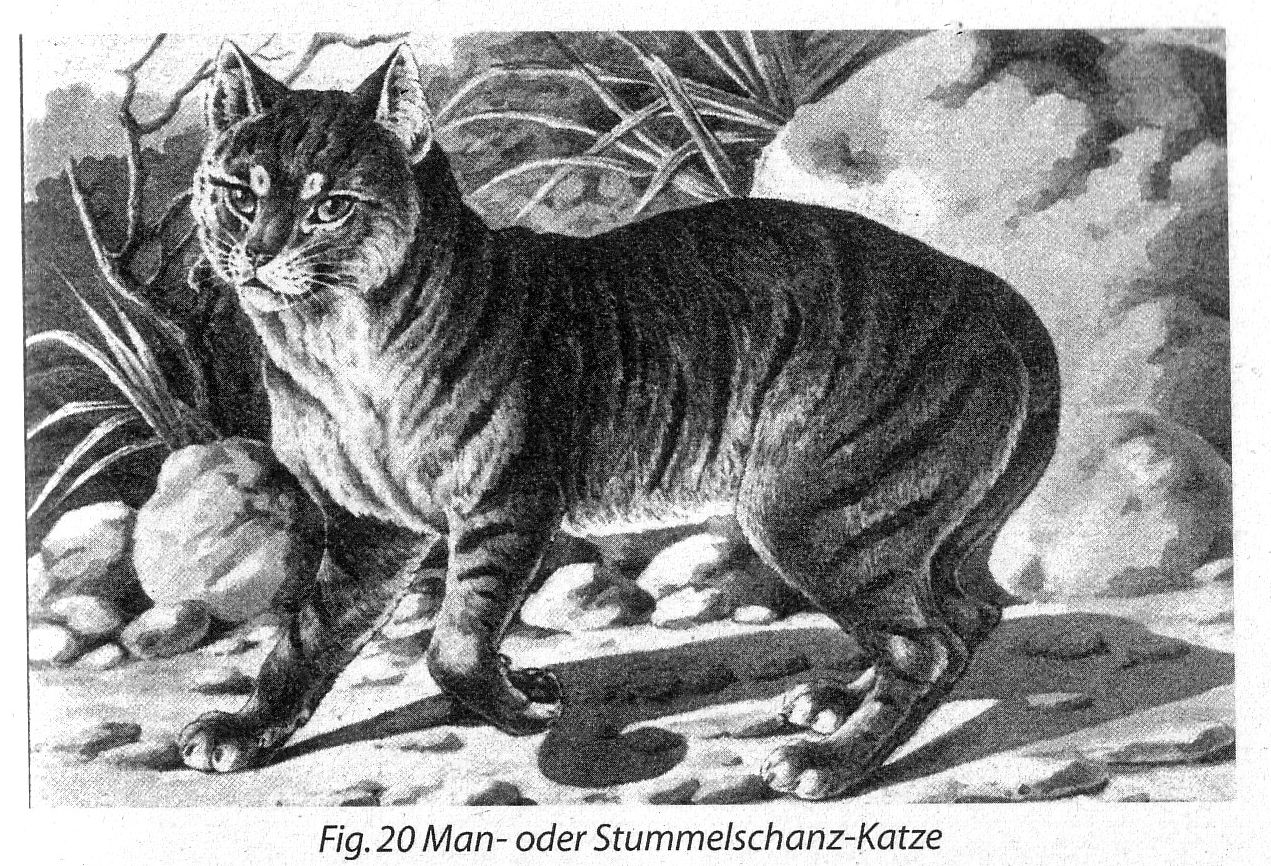
Fig. 20. Manx or Stump-tailed cat.
The Manx or Stump-tailed cat (Felis maniculata domestica ecaudatus) (Fig. 20) one comes from the Isle of Man. Keller wrote the following description in his cat book Supplement to the Animal Market) concerning the tailless cat: "The feral cat of Cornwall and on the Isle of Man (off the north-west coast of England) is a distinct race and usually has only the slightest suggestion of a tail. There are however part-tailed cats also, probably taking after the father. They come in different colours and they also have rather long paws ". The Manx cat is no ordinary-looking animals due to the absence of a tail and its greatly elevated hindquarters; the hind legs are disproportionately long and therefore the cats stand higher at the back. This design allows it to safely jump enormous lengths from branch to branch; it is an excellent tree-cat and a great danger to birds.
According to Brehm, who saw Martens on the Sunda Isles, and saw cats with different tail gradations on several occasions in Japan, and Kessel told Weinland that in those areas, in particular on Sumatra, the cats’ original tails died and dropped off as the cats grew up. The Manx cat occurs in different colouring.
The cat of Cochinchina is to have only a short, curled tail and the Madagascar cat has atwisted, knotted tail.
The following cats are very similar to the common housecat and differ only in their colouring. For example, the Icelandic cat is a beautifully bluish grey, the Tobolsk cat from Siberia is red or fox-coloured, and those from the Cape of Good Hope are blue or red.
The Frankfurt zoological garden received a pair of cats from Central America, which were distinctive because of their size, their silky-woolly hair and their dark ash-grey, black-striped colour.
While we have rich knowledge of the breeds and varieties of other domestic animals, the different varieties of cat are only poorly reported and not very well described. This is all the more surprising when you consider that the cat was one of the oldest domestic animals and was historically a favoured animal. In this article I have tried to draw together information I have found in literature along with my own observations and studies. The illustrations in this section are, as far as possible, reproduced faithfully from life to give the esteemed reader and cat-lover an accurate representation of the races and breeds described.
